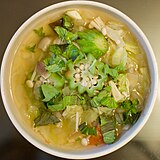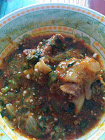
Dashi is a family of stocks used in Japanese cuisine. Dashi forms the base for miso soup, clear broth soup, noodle broth soup, and many simmering liquids to accentuate the savory flavor known as umami. Dashi is also mixed into the flour base of some grilled foods like okonomiyaki and takoyaki.

Gumbo is a stew that is popular in the U.S. state of Louisiana, and is the official state cuisine. Gumbo consists primarily of a strongly flavored stock, meat or shellfish, a thickener, and the Creole "holy trinity" – celery, bell peppers, and onions. Gumbo is often categorized by the type of thickener used, whether okra or filé powder.
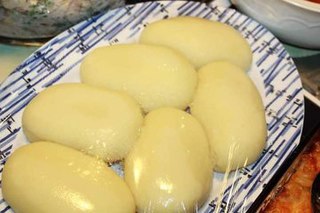
Fufu is a pounded meal found in West African cuisine. It is a Twi word that originates from the Akans in Ghana. The word has been expanded to include several variations of the pounded meal found in other African countries including Sierra Leone, Guinea, Liberia, Cote D'Ivoire, Burkina Faso, Benin, Togo, Nigeria, Cameroon, the Democratic Republic of Congo, the Central African Republic, the Republic of Congo, Angola and Gabon. It also includes variations in the Greater Antilles, where African culinary influence is high.
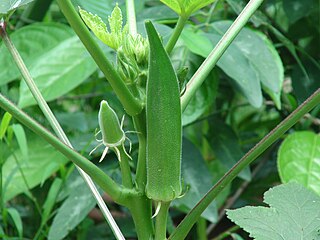
Okra, Abelmoschus esculentus, known in some English-speaking countries as lady's fingers, is a flowering plant in the mallow family native to East Africa. It has edible green seed pods. Cultivated in tropical, subtropical, and warm temperate regions around the world, okra is used in the cuisines of many countries.

Ugali, also known as posho, nsima, and other names, is a type of corn meal made from maize or corn flour in several countries in Africa. It is cooked in boiling water or milk until it reaches a stiff or firm dough-like consistency. In 2017, the dish was added to the UNESCO Representative List of the Intangible Cultural Heritage of Humanity, one of a few foods in the list.

Soto ayam is a traditional Indonesian dish with ingredients such as chicken, lontong, noodles, and rice vermicelli. Soto ayam is popular in Singapore, Malaysia and Suriname. Turmeric is added as one of its main ingredients which makes the yellow chicken broth. It is one of the most popular variants of soto, a traditional soup commonly found in Indonesian cuisine. Besides chicken and vermicelli can also be served with hard-boiled eggs, slices of fried potatoes, and Chinese celery leaves. Fried shallots are usually added as a garnish. Coconut milk (santan) is also used as an additional ingredient. Koya, a powder of mixed prawn crackers with fried garlic, or sambal is a common topping. Krupuk or emping is also a common topping. Lalapan is usually served as a side dish.

Egusi (Yoruba) is the name for the protein-rich seeds of certain cucurbitaceous plants, which, after being dried and ground, are used as a major ingredient in West African cuisine.

Noodle soup refers to a variety of soups with noodles and other ingredients served in a light broth. Noodle soup is a common dish across East Asia, Southeast Asia and the Himalayan states of South Asia. Various types of noodles are used, such as rice noodles, wheat noodles and egg noodles.
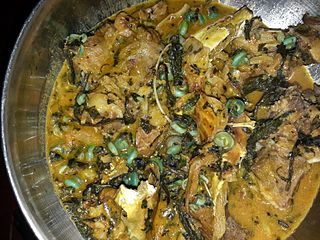
Ogbono soup is a Nigerian dish made with ground dry ogbono seeds. Ogbono seeds are originated and were first grown in Southern Nigeria with considerable local variation. According to research by Chris Chinaka and J.C. Obiefuna, Ogbono is an indigenous forest tree associated with plants classified as 'non-timber forest products. It goes by various indigenous names among Nigerians. Common use of the word “ogbono” in general Nigerian parlance stems from the Igbo name for the word. Among the Nupe, it is called 'pekpeara', 'ogwi' in Bini, 'uyo' in Efik, and 'oro' or ‘apon’ in Yoruba. Although ogbono and ugiri, the Igbo name for bush-mango, are very similar indeed and often regarded as equivalents, there is technically a distinction.

Peanut stew or groundnut stew, also known as maafe, sauce d'arachide (French) or tigadèguèna is a stew that is a staple food in Western Africa. It originates from the Mandinka and Bambara people of Mali.

Nigerian cuisine consists of dishes or food items from the hundreds of Native African ethnic groups that comprises Nigeria. Like other West African cuisines, it uses spices and herbs with palm oil or groundnut oil to create deeply flavored sauces and soups.

Soup is a primarily liquid food, generally served warm or hot, that is made by combining ingredients of meat or vegetables with stock, milk, or water. Hot soups are additionally characterized by boiling solid ingredients in liquids in a pot until the flavors are extracted, forming a broth. Soups are similar to stews, and in some cases there may not be a clear distinction between the two; however, soups generally have more liquid (broth) than stews.

Cheese soup is a type of soup prepared using cheese as a primary ingredient, along with milk, broth and/or stock to form its basis. Various additional ingredients are used in its preparation, and various types and styles of cheese soup exist. It is a part of some cuisines in the world, such as American, Colombian, Mexican, Swiss, French, and Tibetan cuisines. Mass-produced cheese soups may be prepared with the addition of food additives to preserve them and enhance flavor. A list of cheese soups is included in this article.
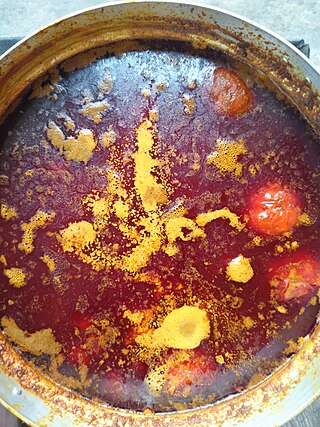
Palm nut soup or banga is a soup made from palm fruit common in the Cameroonian, Ghanaian, Nigerian, Democratic Republic of Congo and Ivorian communities. The soup is made from a palm cream or palm nut base with stewed marinated meats, smoked dried fish, and aromatics. It is often eaten with starch, fufu, omotuo, banku, fonio, or rice. The use of the palm fruit in cooking is significant in Ivorian, Cameronian, Nigerian, Ghanaian, Liberian and other West and Central African cuisine.

Carrot soup is a soup prepared with carrot as a primary ingredient. It can be prepared as a cream- or broth-style soup. Additional vegetables, root vegetables and various other ingredients can be used in its preparation. It may be served hot or cold, and several recipes exist.

Afang soup, is a vegetable soup that originates from the Ibibio People of Akwa Ibom in Southern Nigeria. They share this soup with their neighbors the [Efik] people of [Efik Tribe] in Calabar, Cross River It is a dish popularly known by Nigerians and also some parts of Africa. It is especially popular among the Ibibio and the Anang people of Akwa Ibom and Cross River state who have adopted this cuisine as part of their cultural identity. It's served at homes and also sometimes in ceremonies such as weddings, burials, festivals etc. mostly in the southern part of Nigeria. Afang soup is very nutritious and the cost of preparation can be adaptable based on family needs.

Vegetable soup is a common soup prepared using vegetables and leaf vegetables as primary ingredients. It dates to ancient history, and is a mass-produced food product in contemporary times.
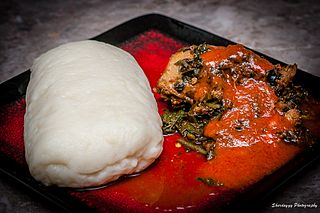
Pounded yam or Iyán (Yoruba) or Ruam-Yo (Tiv) is a Nigerian swallow food native to the Yoruba, Igbo Edo, Tiv and Ebira ethnic groups. It is a traditional food prepared by pounding boiled yam with a mortar and pestle. Pounded yam is similar to mashed potatoes but heavier in consistency. It is a smooth and tasty delicacy traditionally eaten with the hands.

